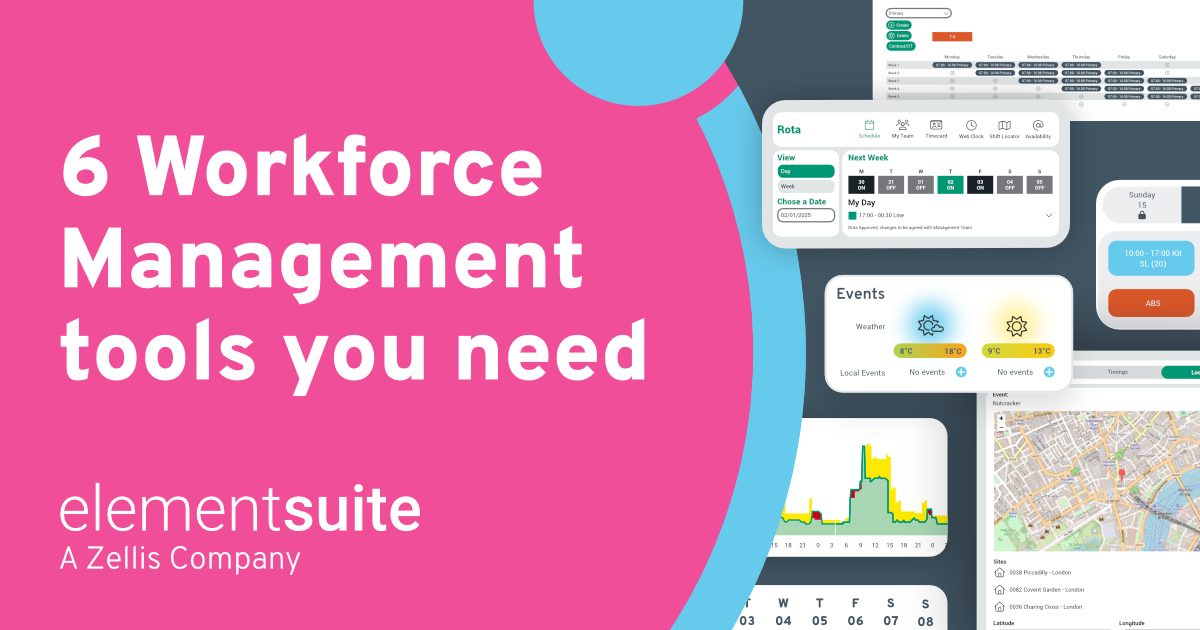We’re all human, and mistakes are an inevitable part of our day-to-day lives. However, scheduling mishaps, in particular, though may seem trivial, in reality they can lead to disproportionate consequences within an organisation.
The smallest mistakes can have a domino effect, causing major chaos – impairing productivity disrupting workflow, affecting employee morale, and ultimately, harming the bottom line.
That’s why it’s essential to be aware of the common mistakes that can occur in staff scheduling and how to avoid them.
1. Lack of advanced planning
Research shows that waiting until the last minute to send out rotas opens the door to all sorts of employee well-being issues: unhappy teams, distressed employees, and even the dreaded burnout.
Not creating schedules in advance
Creating employee schedules well in advance is crucial to maintaining a smooth operational flow within any organisation. One top tip to avoid walking into the doors of chaos is by recycling schedules from the previous week. This can serve as a foundational template for future schedules, making real-time changes as necessary for absences or special events.
Ignoring peak hours and customer demands
This has to be one of the most common mistakes made by organisations. It cannot be stressed enough how effective scheduling must incorporate a deep understanding of when your business experiences its highest activity levels. Analyse your sales data, observing seasonal trends or promotional periods, so that you can accurately forecast demand. This insight allows for crafting staffing schedules that not only meet but exceed customer expectations during these peak hours.
2. Poor communication
Lack of communication in any setting can lead to misunderstandings, conflicts, and overall disarray. In fact, an Economist Intelligence Unit’s study, highlights that miscommunication contributes significantly to stress, failure to complete projects, and loss of sales.
So, if you still use a paper-based scheduling system, then you might need to reconsider. Yes, you can argue that all employees are given a copy via email. But what happens when last-minute changes to the schedule occur? Are employees stuck in limbo, unsure when to work until they receive an email with the updated changes?
What about when employees want to swap shifts? Simply messaging their managers on WhatsApp is not the most secure or efficient method either. Messages can be deleted, and if you ever find yourself in a dispute over working hours, you have no record of any shift changes or requests. Plus when it comes to security and data protection, messaging apps are not exactly GDPR compliant.
Wouldn’t it be better if you had a centralised scheduling system where employees have real-time access to their schedules, clear records of approvals, and a formal process for requesting swaps or time off?
3. Ignoring employee preferences and skill sets
Accommodating employee preferences for shifts or days off goes beyond courtesy. It’s a strategic move that can boost team morale and productivity.
A well-planned schedule should consider the following:
- Employee availability and work preferences
- Employee skill sets
- Validation of qualifications and right-to-work documentation
However, it’s important to note that when we talk about employee preferences, this goes beyond working specific shifts or preferred days off. It also includes considering factors like team dynamics. Knowing who works well together and who doesn’t can prevent unnecessary tension and keep the workplace atmosphere positive.
4. Not providing enough training for adaptability
As business needs change (as they will), it is inevitable that we are going to have those hollow skills gaps in our schedules. But instead of frantically calling the overpriced recruitment consultancy on your preferred supplier list, or scheduling in an inexperienced worker for a shift they are not qualified to undertake, why not mitigate these risks by considering upskilling your current staff?
High-performing organisations like Cisco and Google have already recognised the value of investing in their employees. They offer cross-collaboration training schemes that work on building employees’ skills and competencies, ensuring they are equipped to handle any task assigned to them.
It’s a simple yet effective tactic: providing your team with the necessary tools and knowledge creates a more versatile workforce that can adapt to change and boost overall efficiency.
Introducing a savvy training mobile-friendly software offering a wealth of online materials can make that difference. For new employees, having access to training information during onboarding can significantly reduce the learning curve and lead to faster productivity. For more established employees, this can offer opportunities for continuous development and growth. And for managers, this is the Holy Grail to achieving internal mobility, filling in skills gaps, and reducing labour costs.
5. Inflexibility
Following up on the previous point, it’s essential to have a certain level of flexibility in your scheduling system. Not only do employees want more flexibility in their schedules, but because research finds that contingency planning can significantly enhance organisational performance.
Therefore, having a backup plan or being able to quickly find replacements for unexpected absences can save your business from losing revenue or facing operational challenges.
This means having access to a pool of trained employees who can step in at short notice, including offering them opportunities to work in different locations if the business operates across multiple sites.
It all boils down to having clear communication strategies that keep everyone on the same page. Employees should be well-informed on schedule changes and feel confident that their needs will be considered. Equally, managers should have a backup plan and know who can fill in if needed.
6. Not recognising employee efforts in accommodating scheduling needs
Employee productivity, performance, and engagement are 14% higher in organisations with recognition programs than in those without them.
So, make it a point to appreciate employees who go the extra mile to fill last-minute shifts, volunteer for special events, or show exceptional customer service.
When employees feel seen and valued for their work, it inherently boosts their morale and drives them to maintain or even elevate their performance level (and be more inclined to take on more shifts when needed). Conversely, failing to acknowledge employees’ hard work has the antithesis effect. When employees feel unappreciated, they will be less willing to help you fill last-minute shifts.
All it takes is a direct message from a manager or public acknowledgement on company-wide communications platforms. This visibility celebrates the individual’s contributions and motivates others by setting a positive example.
It also involves acknowledging their career aspirations and actively supporting their growth within the company. Setting up a transparent career map accessible via your HR platform allows employees to take ownership of their career progression. You could even schedule them to shadow and learn from different departments to provide valuable growth opportunities.
7. Too much overtime
Do you know your forecasted hours versus your actuals? Do you find that, more often than not, your employees are working overtime to meet deadlines and cover shifts? While occasional overtime may be necessary, a longitudinal study covering the effect of overtime on occupational health over 10 years found that too much can have severe consequences.
The study found that employees who worked more than 40 hours a week reported significantly higher levels of work-related stress and fatigue, with an increased susceptibility to injury.
To avoid this, it’s essential to have an effective scheduling system that considers workload and staff availability. This means using data and analytics to forecast busy periods and proactively scheduling enough staff to cover the workload.
However, make sure that the software notifies you when overtime and working hour limits are approaching. Setting up these alerts ensures that managers are promptly informed when employees are nearing their maximum allowable hours, facilitating proactive adjustments to the schedule.
These notifications play a pivotal role in preventing unintentional overtime, enabling a balanced scheduling approach that prioritises operational efficiency and employee well-being. Not to mention avoid breaching Working Time Regulations.
8. Not giving enough notice
Last-minute schedule changes can be disruptive and stressful for employees, especially for those with personal or family commitments outside of work. In fact, research by The Shift Project found that about two-thirds of service sector workers who were exposed to unstable and unpredictable scheduling practices, such as short notice for shifts, on-call shifts, and clopening shifts, report higher levels of psychological distress. They also experience poorer sleep quality and are generally less happy compared to workers with more predictable schedules.
It’s safe to say that if you want to avoid this mistake, providing adequate notice for schedule changes is crucial. This includes notifying them of shift changes and overtime requests in a timely manner – ideally two weeks in advance.
Autoscheduling technology enhances this process by ensuring schedules are distributed well in advance, allowing employees to plan their commitments accordingly.
It takes minimum effort and time to consider employees’ availability and preferences when creating a schedule based on the business needs. Plus, with the ability to easily make adjustments as needed, managers can ensure a fair and balanced schedule for all employees.
9. Not measuring schedule efficiency
Last but definitely not least is the failure to measure schedule efficiency. Without tracking and analysing scheduling data, how do you truly know if your scheduling processes are effective?
Organisations that deploy workforce planning analytics are found to be 66% more likely to increase HR performance efficiency without increasing HR headcount. Additionally, these businesses are four times more likely to increase workforce ROI compared to those without unified analytics.
To that end, implementing a robust Workforce Management (WFM) tool with advanced analytics is an absolute must if you want to make informed and data-driven decisions about your scheduling processes.
By integrating your scheduling system with sales and booking data, you can identify which schedules align perfectly with demand peaks and troughs. You could also analyse Customer Satisfaction (CSAT) scores concerning specific schedules to gain invaluable insights into how individual or team performance impacts customer service.
Metrics such as schedule adherence, overtime costs, and employee turnover rates can also provide valuable information on the effectiveness of your scheduling process, identifying areas for improvement and making data-driven decisions to optimise your scheduling system.
Conclusions
In conclusion, effective scheduling goes beyond creating a schedule that meets business needs. It’s about balancing operational efficiency and employee well-being while continuously seeking opportunities to improve and enhance the scheduling process. By implementing technology, providing enough notice for schedule changes, recognising employee contributions, and measuring schedule efficiency, you can create a scheduling system that benefits both your employees and your organisation.
Book a demo today to learn more about how our WFM tool can help you achieve optimal scheduling results.




